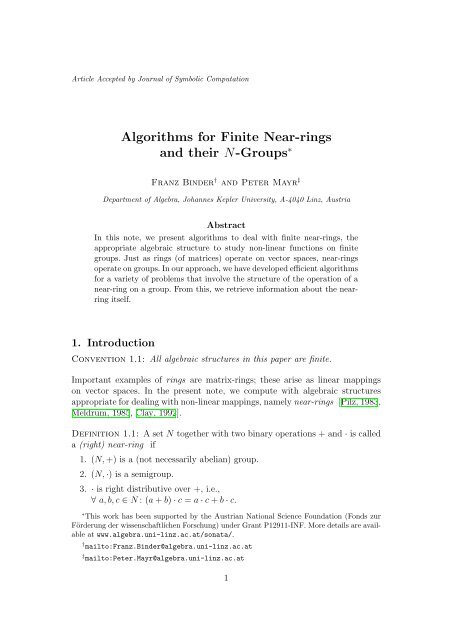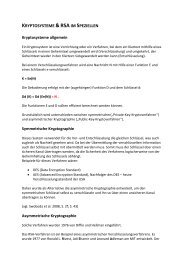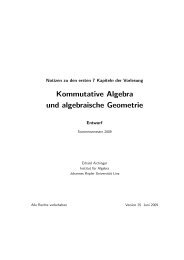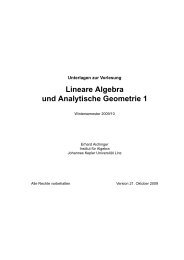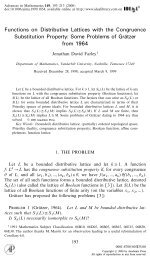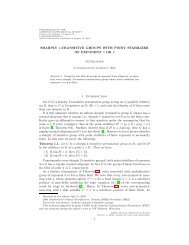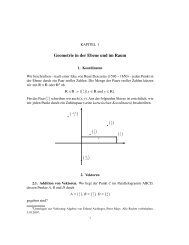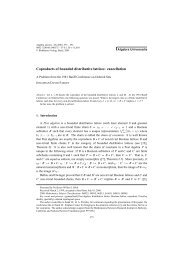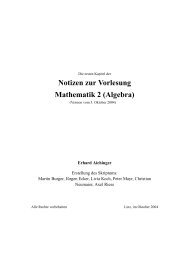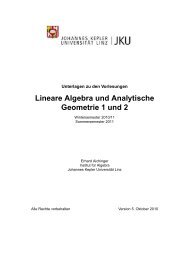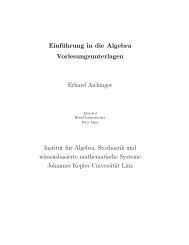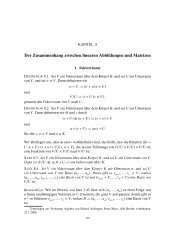Algorithms for Finite Near-rings and their N-Groups
Algorithms for Finite Near-rings and their N-Groups
Algorithms for Finite Near-rings and their N-Groups
Create successful ePaper yourself
Turn your PDF publications into a flip-book with our unique Google optimized e-Paper software.
Article Accepted by Journal of Symbolic Computation<br />
<strong>Algorithms</strong> <strong>for</strong> <strong>Finite</strong> <strong>Near</strong>-<strong>rings</strong><br />
<strong>and</strong> <strong>their</strong> N-<strong>Groups</strong> ∗<br />
Franz Binder † <strong>and</strong> Peter Mayr ‡<br />
Department of Algebra, Johannes Kepler University, A-4040 Linz, Austria<br />
Abstract<br />
In this note, we present algorithms to deal with finite near-<strong>rings</strong>, the<br />
appropriate algebraic structure to study non-linear functions on finite<br />
groups. Just as <strong>rings</strong> (of matrices) operate on vector spaces, near-<strong>rings</strong><br />
operate on groups. In our approach, we have developed efficient algorithms<br />
<strong>for</strong> a variety of problems that involve the structure of the operation of a<br />
near-ring on a group. From this, we retrieve in<strong>for</strong>mation about the nearring<br />
itself.<br />
1. Introduction<br />
Convention 1.1: All algebraic structures in this paper are finite.<br />
Important examples of <strong>rings</strong> are matrix-<strong>rings</strong>; these arise as linear mappings<br />
on vector spaces. In the present note, we compute with algebraic structures<br />
appropriate <strong>for</strong> dealing with non-linear mappings, namely near-<strong>rings</strong> [Pilz, 1983,<br />
Meldrum, 1985, Clay, 1992].<br />
Definition 1.1: A set N together with two binary operations + <strong>and</strong> · is called<br />
a (right) near-ring if<br />
1. (N, +) is a (not necessarily abelian) group.<br />
2. (N, ·) is a semigroup.<br />
3. · is right distributive over +, i.e.,<br />
∀ a, b, c ∈ N : (a + b) · c = a · c + b · c.<br />
∗ This work has been supported by the Austrian National Science Foundation (Fonds zur<br />
Förderung der wissenschaftlichen Forschung) under Grant P12911-INF. More details are available<br />
at www.algebra.uni-linz.ac.at/sonata/.<br />
† mailto:Franz.Binder@algebra.uni-linz.ac.at<br />
‡ mailto:Peter.Mayr@algebra.uni-linz.ac.at<br />
1
F. Binder <strong>and</strong> P. Mayr: <strong>Near</strong>-<strong>rings</strong> <strong>and</strong> N-<strong>Groups</strong> 2<br />
The equality f0 = 0 <strong>for</strong> f ∈ N is not implied by these axioms.<br />
Definition 1.2: The zero-symmetric part of a near-ring N is usually denoted<br />
by N 0 <strong>and</strong> defined by N 0 := {f ∈ N | f0 = 0}. Also, both the elements of N 0<br />
<strong>and</strong> any near-ring that fulfills N = N 0 are called zero-symmetric. A near-ring<br />
with commutative addition is called abelian.<br />
Note that the missing left distributive law, a(b + c) = ab + ac, has to do with<br />
linearity if a is considered as a function. In fact, functions on groups are the<br />
typical examples of near-<strong>rings</strong>. Let Γ be a group, <strong>and</strong> let M(Γ) be the set of<br />
all mappings from Γ into Γ (we will call them trans<strong>for</strong>mations). We define +<br />
<strong>and</strong> · on M(Γ) by (f + g)(γ) := f(γ) + g(γ) <strong>and</strong> (f · g)(γ) := f(g(γ)). Then<br />
(M(Γ), +, ·) is a near-ring, the full trans<strong>for</strong>mation near-ring. For the appropriate<br />
algebraic sub-structures, the sub-near-<strong>rings</strong>, we then write N ≤ M(Γ) <strong>and</strong> call<br />
them trans<strong>for</strong>mation near-<strong>rings</strong>. In fact, every near-ring can be represented as a<br />
trans<strong>for</strong>mation near-ring on some group Γ. But we are interested mainly in the<br />
natural case, where Γ is small, <strong>and</strong> N is (very) big, but generated by a small<br />
number of generators. If small means 100, then N can have up to 100 100 elements,<br />
which is almost infinite ([Scott, 1979] contains many impressive examples). In<br />
particular, big means that the elements of N cannot be enumerated in practice,<br />
whereas small means that it is no problem to loop over all elements of Γ, or<br />
over all generators. So our main concern is to compute as much as we can with<br />
generators only. We note that a corresponding problem in group theory is solved<br />
via Sim’s stabilizing chains [Sims, 1970]. Though we could not develop such a<br />
powerful tool <strong>for</strong> near-ring theory, we can give solutions <strong>for</strong> many important<br />
special cases as well as completely satisfactory solutions to a variety of related<br />
problems.<br />
In contrast to ring theory, no systematic attempt of an algorithmic treatment<br />
of near-ring theory seems to have been done so far, apart from Binder et al.<br />
[2000] <strong>and</strong> a project funded by the Austrian Science Fonds, which resulted in the<br />
development of the package SONATA based on GAP 4 [Aichinger et al., 2000].<br />
This article contains some of the theory behind the development of that package<br />
<strong>and</strong> extends Binder et al. [2000] by a more complete <strong>and</strong> better structured set<br />
of algorithms <strong>for</strong> N-groups, including the efficient computation of commutators.<br />
All these methods now also work <strong>for</strong> N 0 -subgroups, where N (not N 0 ) is given<br />
by generators. We consider centralizer near-<strong>rings</strong>, in particular those with a<br />
group of fixed-point-free automorphisms. A straight<strong>for</strong>ward, but very effective<br />
method to compute N-endomorphisms allows us to significantly generalize the<br />
previous solution to the realizability problem, using a more general interpolation<br />
algorithm together with more precise density results.<br />
2. N-<strong>Groups</strong><br />
Just in the same way as R-modules or vector spaces are used in ring theory,<br />
N-groups are used in near-ring theory.
F. Binder <strong>and</strong> P. Mayr: <strong>Near</strong>-<strong>rings</strong> <strong>and</strong> N-<strong>Groups</strong> 3<br />
Definition 2.1: Let N be a near-ring. An N-group is an additive group Γ<br />
together with an operation of N on Γ (i.e., a mapping N × Γ → Γ), denoted by<br />
juxtaposition, such that <strong>for</strong> all n, m ∈ N <strong>and</strong> γ ∈ Γ,<br />
(n + m)γ = nγ + mγ,<br />
(nm)γ = n(mγ).<br />
We say that N operates faithfully on Γ (or that Γ is a faithful N-group) if<br />
nγ = 0 <strong>for</strong> all γ ∈ Γ is true only if n = 0.<br />
Remark 2.1: Equivalently, an N-group can be described by a homomorphism<br />
from the near-ring N into M(Γ), which is an embedding iff the operation is<br />
faithful.<br />
As <strong>for</strong> R-modules, the actual operation is always to be understood from the<br />
context.<br />
N-groups are always written additively, even if they are not abelian.<br />
For each fixed near-ring N, the N-groups <strong>for</strong>m a variety (just as the near-<strong>rings</strong><br />
themselves). General definitions are obtained from the corresponding ones from<br />
group theory by prefixing them with the near-ring involved. In particular:<br />
Definition 2.2: Let N be a near-ring.<br />
1. A group-homomorphism α between two N-groups Γ 1 <strong>and</strong> Γ 2 is called an<br />
N-homomorphism if <strong>for</strong> all n ∈ N <strong>and</strong> <strong>for</strong> all γ ∈ Γ 1 ,<br />
α(nγ) = n(αγ).<br />
2. A subgroup H of an N-group Γ (we write H ≤ Γ <strong>for</strong> this) is called an<br />
N-subgroup (written as H ≤ N Γ) if it is closed under the operation of N,<br />
i.e., if nγ ∈ H <strong>for</strong> all n ∈ N, γ ∈ H.<br />
3. If H is the kernel of an N-homomorphism, then it is called an N-normal<br />
subgroup <strong>and</strong> we write H N Γ.<br />
Using the term “N-normal” <strong>for</strong> the kernels of homomorphisms (as we do here)<br />
seems to be quite natural but is not st<strong>and</strong>ard in near-ring theory. The notions<br />
“N-ideal” or sometimes “N-module” are used instead by most authors.<br />
Example 2.1:<br />
1. If N ≤ M(Γ), then Γ is a faithful N-group via function application as<br />
operation (or via the identity as the homomorphism into M(Γ)).<br />
2. The additive group (N, +) of a near-ring (N, +, ·) is an N-group via the<br />
near-ring multiplication.
3. N-Subgroups<br />
F. Binder <strong>and</strong> P. Mayr: <strong>Near</strong>-<strong>rings</strong> <strong>and</strong> N-<strong>Groups</strong> 4<br />
For the following, we introduce some useful notations:<br />
Definition 3.1: Let Γ be an N-group, H ≤ Γ, E ⊆ N, <strong>and</strong> F ⊆ Γ. Then<br />
1. 〈E〉 denotes the sub-near-ring generated by E;<br />
2. 〈F 〉 denotes the subgroup generated by F ;<br />
3. 〈E + 〉 denotes the (additive) subgroup generated by E additively;<br />
4. EF := { aγ | a ∈ E, γ ∈ F }.<br />
5. H is called E-invariant if EH ⊆ H;<br />
6. 〈F 〉 E denotes the smallest E-invariant subgroup of Γ containing F ; in particular,<br />
〈F 〉 N denotes the N-subgroup generated by F ;<br />
Note that these definitions apply e.g. when Γ is (N, +). We also use the usual<br />
simplifications <strong>for</strong> singleton sets, e.g., Eγ := E{γ}.<br />
The following is immediate:<br />
Proposition 3.1: Let E be a subset of a near-ring N. Then 〈E〉 = 〈E + 〉 E .<br />
This means that we can use induction proofs over N: to prove a statement <strong>for</strong><br />
all f ∈ N, we just show that it is true <strong>for</strong> all generators <strong>and</strong> that it is closed<br />
under subtraction <strong>and</strong> under multiplications by generators from the left. This<br />
technique is demonstrated by the (easy) proof below.<br />
Proposition 3.2: Let Γ be an N-group, N = 〈E〉, F ⊆ Γ, <strong>and</strong> γ ∈ Γ. Then:<br />
1. 〈F 〉 N = 〈F 〉 E ;<br />
2. Nγ = 〈Eγ〉 E ;<br />
3. NF = ⋃ η∈F Nη.<br />
Proof: For the first part, we have to show that 〈F 〉 E is N-invariant, i.e., that<br />
f(〈F 〉 E ) ⊆ 〈F 〉 E <strong>for</strong> all f ∈ N. We use induction on f.<br />
Base case: For f ∈ E, the statement is true by definition.<br />
Subtraction case: Assume that it is true <strong>for</strong> f <strong>and</strong> g in E, <strong>and</strong> let η ∈ 〈F 〉 E .<br />
Then, (−f +g)η = −fη +gη ∈ 〈F 〉 E , by induction <strong>and</strong> because 〈F 〉 E is a group.<br />
Multiplication case: Finally, assume that the statement is true <strong>for</strong> f ∈ N <strong>and</strong><br />
take e ∈ E, η ∈ 〈F 〉 E . Then,<br />
(ef)η = e( fη<br />
}{{}<br />
∈〈F 〉 E<br />
) ∈ 〈F 〉 E ,<br />
by induction <strong>and</strong> because 〈F 〉 E is E-invariant.<br />
The other parts are immediate.<br />
✷
F. Binder <strong>and</strong> P. Mayr: <strong>Near</strong>-<strong>rings</strong> <strong>and</strong> N-<strong>Groups</strong> 5<br />
Algorithm 1 Computing Orbits<br />
Let Γ be an N-group.<br />
Require: N = 〈E〉, F ⊆ Γ.<br />
Ensure: H = 〈F 〉 E<br />
H := 〈F 〉<br />
while EH H do<br />
H := 〈H ∪ EH〉<br />
end while<br />
These results lead to easy, but essential, algorithms.<br />
Corollary 3.1: Under the same hypotheses, 〈F 〉 N , Nγ, {Nη | η ∈ Γ}, <strong>and</strong><br />
NF can be computed within O(|E| |Γ|) operations.<br />
Proof: From the proposition, the method to compute 〈F 〉 E is obvious <strong>and</strong> made<br />
explicit in Algorithm 1. The computation of Nγ is just a special case of this. And<br />
NF is just the union of the Nη’s. To obtain the complexity bound, note first that<br />
all of the necessary group-oriented operations (i.e., generating subgroups) can<br />
be done within the bound <strong>and</strong> need not be counted. What essentially remains<br />
to be done is to compute all products eη <strong>for</strong> e ∈ E <strong>and</strong> <strong>for</strong> each η in the result,<br />
which is at most Γ. Thus, with appropriate storage of the intermediate results,<br />
we still do not exceed the bound.<br />
✷<br />
Remark 3.1: If N is a near-ring with identity, then NF = 〈F 〉 N .<br />
Remark 3.2: If we add some obvious book-keeping to Algorithm 1, we can<br />
compute more in<strong>for</strong>mation. For example, <strong>for</strong> each η ∈ Nγ, we then can determine<br />
an appropriate f ∈ N such that η = fγ. We could even store how f is constructed<br />
from the generators in E.<br />
4. Difference Operator<br />
Computations in spaces of continuous functions are usually per<strong>for</strong>med using linearization<br />
via the differential operator. In the discrete case, we can do something<br />
similar with a difference operator. We define it in the following way.<br />
Definition 4.1: Let N be a near-ring <strong>and</strong> Γ an N-group. For f ∈ N <strong>and</strong><br />
x, a ∈ Γ, we define<br />
∆fxa := −fx + f(x + a),<br />
<strong>and</strong> call it the difference of f at x in direction a.<br />
Thus the operator ∆ is understood to map an element of N into a function<br />
that maps elements of Γ into elements of M(Γ). In particular, ∆fx ∈ M(Γ). This<br />
operator is also useful in the case Γ = N.
F. Binder <strong>and</strong> P. Mayr: <strong>Near</strong>-<strong>rings</strong> <strong>and</strong> N-<strong>Groups</strong> 6<br />
Proposition 4.1: With the notation of the definition we have<br />
∆fx(a + b) = ∆fxa + ∆f(x + a)b, (quasi-linearity) (1)<br />
∆f(x + a)b = −∆fxa + ∆fx(a + b). (translation rule) (2)<br />
Proof: Of course, both equations are equivalent. We show (2):<br />
−∆fxa + ∆fx(a+b) = −f(x+a) + fx − fx + f(x+a+b)<br />
= ∆f(x+a)b. ✷<br />
Proposition 4.2: Continuing the above notation <strong>and</strong> with g ∈ N, we have<br />
∆(f + g)xa = −gx + ∆fxa + gx + ∆gxa,<br />
∆(−f)xa = −(fx + ∆fxa − fx).<br />
Proof: We show the second equation: ∆(−f)xa = −(−f)x+(−f)(x+a) = fx−<br />
f(x+a) = −(f(x+a)−fx) = −(fx−fx+f(x+a)−fx) = −(fx+∆fxa−fx).<br />
✷<br />
Thus, in general, ∆ is not linear in the first argument unless Γ is abelian. When<br />
considering normal subgroups, these annoying conjugations are absorbed.<br />
Of course, the definition of the difference operator should mirror that of the<br />
differential operator <strong>for</strong> functions on linear spaces. In contrast to the latter, the<br />
difference at a point, ∆fx, need not be a linear function. Equation (1), however,<br />
suggests that it is not too far away. In particular, if we know the difference in<br />
directions generating Γ (as a group), then we know it in any direction. This is<br />
similar to partial derivatives. On the other h<strong>and</strong>, the equivalent equation (2)<br />
shows that the difference at 0, ∆f0, already determines the difference at any<br />
point ∆fx. This is far away from the idea that the difference at a point should<br />
describe a function locally.<br />
Proposition 4.3: The operator ∆ fulfills the following chain rule:<br />
∆(fg)xa = ∆f(gx)∆gxa. (3)<br />
Proof: ∆(fg)xa = −fgx + fg(x + a) = −fgx + f(gx + ∆gxa) = ∆f(gx)∆gxa.<br />
✷<br />
The difference operator can be iterated in the following way. The definition is<br />
motivated by the <strong>for</strong>malism ∆ n+1 f = ∆(∆ n f).<br />
Definition 4.2: Let Γ be an N-group, f ∈ N, x, a, b ∈ Γ, a ∈ Γ n . Then we<br />
define the higher order difference operators as<br />
∆ n+1 fxba := −∆ n fxa + ∆ n f(x + b)a.
F. Binder <strong>and</strong> P. Mayr: <strong>Near</strong>-<strong>rings</strong> <strong>and</strong> N-<strong>Groups</strong> 7<br />
In particular,<br />
∆ 2 fxba = ∆(∆f)xba<br />
= −∆fxa + ∆f(x + b)a<br />
= −f(x + a) + fx − f(x + b) + f(x + b + a).<br />
Remark 4.1: If Γ is abelian, then ∆ n is symmetric in the last n arguments.<br />
Proposition 4.4: ∆ 2 fulfills the following chain rule:<br />
∆ 2 (fg)xba = ∆ 2 f(gx)(∆gxa)(∆gxb) + ∆f (g(x + b) + ∆gxa) ∆ 2 gxab.<br />
Proof: We compute<br />
∆ 2 (fg)xba = −∆(fg)xa + ∆(fg)(x + b)a<br />
= −∆f(gx) (∆gxa) + ∆f (g(x + b)) (∆gxa)<br />
− ∆f (g(x + b)) (∆gxa) + ∆f (g(x + b)) (∆g(x + b)a)<br />
= ∆ 2 f(gx)(∆gxb)(∆gxa) + ∆f (g(x + b) + ∆gxa) (∆ 2 gxba).<br />
The last stage has used the translation rule (2) with x ↦→ g(x+b) <strong>and</strong> a ↦→ ∆gxa.<br />
✷<br />
Definition 4.3: Let E ⊆ N <strong>and</strong> A, F ⊆ Γ.<br />
1. By ∆EAF := { ∆eaγ | e ∈ E, a ∈ A, γ ∈ F }, the ∆-operator can be<br />
applied to sets, <strong>and</strong> we use the obvious modifications <strong>for</strong> singleton sets.<br />
2. We say that F is ∆EA-invariant iff ∆EAF ⊆ F ;<br />
3. (F ) ∆EA denotes the smallest ∆EA-invariant normal subgroup containing F .<br />
5. N-Normal Subgroups<br />
N-normal subgroups, are usually characterized as follows.<br />
Proposition 5.1: Let Γ be an N-group <strong>and</strong> H a subgroup of Γ. Then H N Γ<br />
iff H Γ <strong>and</strong><br />
−fγ + f(γ + η) ∈ H <strong>for</strong> all η ∈ H, f ∈ N, <strong>and</strong> γ ∈ Γ.<br />
Note that −fγ + f(γ + η) = ∆fγη. In fact, we can express this as<br />
Corollary 5.1: A normal subgroup of Γ is N-normal iff it is ∆NΓ-invariant.<br />
N-normal subgroups of N + (i.e., N considered as an N-group) are called left<br />
ideals.<br />
Corollary 5.2: A left ideal of a near-ring N is a ∆NN-invariant normal<br />
subgroup.
F. Binder <strong>and</strong> P. Mayr: <strong>Near</strong>-<strong>rings</strong> <strong>and</strong> N-<strong>Groups</strong> 8<br />
An efficient method to compute N-normal subgroups is provided by a stronger<br />
result.<br />
Proposition 5.2: Let Γ be an N-group with N = 〈E〉. A normal subgroup is<br />
N-normal iff it is ∆EΓ-invariant.<br />
Proof: Let H be a ∆EΓ-invariant normal subgroup. To show that ∆fΓH ⊆ H<br />
<strong>for</strong> all f ∈ N, we use induction on f. The base case holds. For the subtraction<br />
case, consider ∆(−f + g)xγ = −gx − (fx + ∆fxγ − fx) + gx + ∆gxγ ∈ H,<br />
using Proposition 4.2 <strong>and</strong> by normality. And <strong>for</strong> the multiplication case, consider<br />
e ∈ E <strong>and</strong> f ∈ N fulfilling the statement. Then, using the chain rule (3), we<br />
have ∆(ef)xγ = ∆e(fx)∆fxγ ∈ H, because ∆fxγ ∈ H.<br />
✷<br />
Corollary 5.3: The N-normal subgroup generated by a set I can be computed<br />
within O(|E| |Γ| k) operations, where k is a bound <strong>for</strong> the number of generators<br />
necessary to generate any normal subgroup of Γ.<br />
Proof: By Proposition 5.2, we need to compute (I) ∆EΓ . The straight<strong>for</strong>ward algorithm<br />
is similar to Algorithm 1. This leads to the complexity bound O(|E| |Γ| 2 ).<br />
To improve it, note that we can use quasi-linearity (1).<br />
✷<br />
6. Commutators<br />
In the previous sections, we have developed efficient algorithms to compute the<br />
lattice of N-subgroups as well as the lattice of N-normal subgroups, i.e., the<br />
congruence lattice of an N group. In addition to this, we would like to be able to<br />
compute the commutator operation on the congruences, in the sense of Universal<br />
Algebra. We will use the notation [X, Y ] N to distinguish the N-commutator (i.e.,<br />
that with respect to the variety of N-groups) from the usual group commutator<br />
[X, Y ]. Using the definition of Gumm [1980], we obtain the following adaptation<br />
<strong>for</strong> N-groups.<br />
Definition 6.1: Let Γ be an N-group of a near-ring N <strong>and</strong> X N Γ, Y N Γ.<br />
With ξ := {(a, a + x) | a ∈ Γ, x ∈ X}, we define<br />
δ Y X := ({ (y, y) | y ∈ Y }) ∆Nξ ;<br />
[X, Y ] N := { z | (0, z) ∈ δ Y X }.<br />
Then [X, Y ] N N Γ, <strong>and</strong> it is called the N-commutator of X <strong>and</strong> Y .<br />
Remember that the congruence associated with a normal subgroup X is given<br />
as ξ above <strong>and</strong> that any N-congruence is an N-subgroup of Γ × Γ.<br />
Theorem 6.1: Let N be a trans<strong>for</strong>mation near-ring generated by E, <strong>and</strong> let X<br />
<strong>and</strong> Y be N-normal subgroups of the N-group Γ, generated additively by I <strong>and</strong> J,<br />
respectively. Then the N-commutator of X <strong>and</strong> Y is the N-normal subgroup of Γ<br />
generated by [X, Y ] <strong>and</strong> ∆ 2 EΓIJ.
F. Binder <strong>and</strong> P. Mayr: <strong>Near</strong>-<strong>rings</strong> <strong>and</strong> N-<strong>Groups</strong> 9<br />
Proof: Let ξ be as in Definition 6.1 <strong>and</strong> Z := ([X, Y ] ∪ ∆ 2 EΓXY ) ∆Nξ .<br />
At first, we show that the commutator [X, Y ] N indeed contains all the generators<br />
of Z. Note that {z | (0, z) ∈ δX Y } = {z | (y, y+z) ∈ δY X }, <strong>for</strong> any y ∈ Y , as δY X<br />
contains all pairs of the <strong>for</strong>m (y, y). Because −(0, x)+(y, y)+(0, x) ∈ δX Y , we have<br />
−y − x + y + x ∈ [X, Y ] N <strong>for</strong> all x ∈ X, y ∈ Y . Similarly, by ∆e(a, a + x)(y, y) =<br />
(∆eay, ∆e(a + x)y) ∈ δX Y , we have −∆eay + ∆e(a + x)y = ∆2 eaxy ∈ [X, Y ] N<br />
<strong>for</strong> all e ∈ N, a ∈ Γ, x ∈ X, y ∈ Y . Thus Z ⊆ [X, Y ] N .<br />
Conversely, to prove Z ⊇ [X, Y ] N , define δ := { (y, y + z) | y ∈ Y, z ∈ Z }.<br />
Below we show that δ is N-normal in ξ. Because δ contains the generators<br />
of δX Y , this means that δ ⊇ δY X <strong>and</strong>, consequently, that Z = {z | (0, z) ∈ δ} ⊇<br />
{z | (0, z) ∈ δX Y } = [X, Y ] N.<br />
For the following, let y 1 , y 2 , y ∈ Y , z 1 , z 2 , z ∈ Z, x ∈ X, <strong>and</strong> a ∈ Γ.<br />
δ is a subgroup: (y 1 , y 1 + z 1 ) − (y 2 , y 2 + z 2 ) = (y 1 − y 2 , y 1 + z 1 − z 2 − y 2 ).<br />
Clearly, y 1 − y 2 ∈ Y , <strong>and</strong> y 2 − y 1 + y 1 + z 1 − z 2 − y 2 = y 2 + (z 1 − z 2 ) − y 2 ∈ Z,<br />
as Z is normal.<br />
δ is normal: (a, a+x)+(y, y +z)−(a, a+x) = (a+y −a, a+x+y +z −x−a)<br />
should be in δ. Clearly, a + y − a ∈ Y , <strong>and</strong>, since Z is normal −(a + y − a) +<br />
(a + x + y + z − x − a) = a −y + x + y − x + x<br />
} {{ } }<br />
+<br />
{{<br />
z − x<br />
}<br />
−a ∈ Z.<br />
∈Z<br />
∈Z<br />
δ is ∆Eξ-invariant: ∆e(a, a + x)(y, y + z) = ( ∆eay, ∆e(a + x)(y + z) ) should<br />
be in δ. Clearly, ∆eay ∈ Y , <strong>and</strong><br />
−∆eay + ∆e(a + x)(y + z) = −∆eay + ∆e(a + x)y + ∆e(a + x + y)z<br />
= ∆ 2 eaxy + ∆e(a + x + y)z ∈ Z.<br />
} {{ } } {{ }<br />
∈Z<br />
∈Z<br />
The validity of the restriction to the additive generators of the ideals again<br />
follows from quasilinearity.<br />
✷<br />
Corollary 6.1: N-commutators of N-normal subgroups of N-groups can be<br />
computed within O(|E| |Γ| k 2 ) operations, with k as in Corollary 5.3.<br />
7. Left Ideals <strong>and</strong> N 0 -Subgroups<br />
Our algorithms <strong>for</strong> computing with an N-group Γ (N given by a small set E of<br />
generators) depend on the efficient computation of orbits (e.g. Nγ). We show<br />
that essentially the same methods work if, instead of N, we encounter a left ideal<br />
given by (left ideal) generators.<br />
Proposition 7.1: Let N be a near-ring, Γ an N-group, <strong>and</strong> L a left ideal of N.<br />
If γ ∈ Γ <strong>and</strong> I is a set of (left ideal) generators of L, then<br />
Lγ = (Iγ) ∆E(Nγ) .
F. Binder <strong>and</strong> P. Mayr: <strong>Near</strong>-<strong>rings</strong> <strong>and</strong> N-<strong>Groups</strong> 10<br />
Proof: Let H := (Iγ) ∆E(Nγ) . For all f ∈ L <strong>and</strong> h ∈ H, we have to show that<br />
fγ ∈ H. We do this by induction on f using L = (I) ∆EN . The base case<br />
is trivial, so are the difference case <strong>and</strong> the conjugation case. For the ∆-case,<br />
consider e ∈ E, n ∈ N, <strong>and</strong> f ∈ L <strong>for</strong> which the statement is true. Then<br />
(∆enf)γ = ∆e( nγ )( fγ ) ∈ H.<br />
}{{} }{{}<br />
∈Nγ ∈H<br />
Corollary 7.1: Lγ can be computed within O(|E| |Γ| k) operations, with k as<br />
in Corollary 5.3.<br />
For an arbitrary subset E of N, we define<br />
E 0 = {−f0 + f | f ∈ E}.<br />
It is immediate that this notation just extends that <strong>for</strong> the zero-symmetric part<br />
of a near-ring. Un<strong>for</strong>tunately, N = 〈E〉 does not imply N 0 = 〈E 0 〉. In fact, we<br />
are not aware of any general efficient method to compute near-ring generators<br />
of N 0 from those of N.<br />
Nevertheless, N 0 is a left ideal of N <strong>and</strong> E 0 generates N 0 as a left ideal.<br />
Proposition 7.2: Let N be a near-ring generated by a set 〈E〉. Then<br />
N 0 = (E 0 ) ∆NN = (E 0 ) ∆EN = (E 0 ) ∆E(N0) .<br />
Proof: That N 0 is a left ideal is well known <strong>and</strong> immediately checked. Let M :=<br />
(E 0 ) ∆EN0 . It remains to prove N 0 ⊆ M. Note that N 0 = {−f0 + f | f ∈ N}.<br />
Thus, we have to show that −f0 + f ∈ M, <strong>for</strong> all f ∈ N, which we prove by<br />
induction on f. The base case, f ∈ E, is trivial. For the difference case, let<br />
f, g ∈ N such that −f0 + f ∈ M <strong>and</strong> −g0 + g ∈ M. We have to show that<br />
−(f − g)0 + (f − g) ∈ M. Using normality,<br />
−(f − g)0 + (f − g) = g0 − f0 + f − g<br />
= g0 − f0 + f − g0 + g0 − g + g0 − g0<br />
= g0 −f0 + f −g0 + g0 − (−g0 + g) − g0 ∈ M.<br />
} {{ }<br />
} {{ }<br />
}<br />
∈M<br />
{{ } }<br />
∈M<br />
{{ }<br />
∈M<br />
∈M<br />
For the multiplication case, we need to show that −ef0 + ef ∈ M <strong>for</strong> e ∈ E<br />
under the assumption that −f0 + f ∈ M. We apply the ∆E(N0)-invariance:<br />
−ef0 + ef = −ef0 + e(f0 − f0 + f)<br />
= ∆e(f0) (−f0 + f) ∈ M.<br />
} {{ }<br />
∈M<br />
Corollary 7.2: Let Γ be an N-group <strong>and</strong> γ ∈ Γ. If N is generated by E, then<br />
N 0 γ = (E 0 γ) ∆E(Nγ) .<br />
✷<br />
✷<br />
Proof: Just combine the previous results.<br />
✷
F. Binder <strong>and</strong> P. Mayr: <strong>Near</strong>-<strong>rings</strong> <strong>and</strong> N-<strong>Groups</strong> 11<br />
8. Centralizer <strong>Near</strong>-<strong>rings</strong><br />
Definition 8.1: Let Γ be a group <strong>and</strong> S be a semigroup of endomorphisms<br />
of Γ. Then the sub-near-ring of M(Γ)<br />
is called a centralizer near-ring.<br />
M S (Γ) := {f ∈ M(Γ) | fs = sf <strong>for</strong> all s ∈ S}<br />
Particular examples are M(Γ) (<strong>for</strong> S = ∅) <strong>and</strong> M 0 (Γ) (<strong>for</strong> S = {0}). In this<br />
context, we use S 0 := S ∪ {0}.<br />
For a centralizer near-ring, it is easy to decide whether it contains a given<br />
f ∈ M(Γ). This is in contrast to the case of trans<strong>for</strong>mation near-<strong>rings</strong>. Dually,<br />
it is hard to compute non-trivial elements of an arbitrary centralizer near-ring<br />
(easy <strong>for</strong> a trans<strong>for</strong>mation near-ring).<br />
An automorphism α of Γ is called fixed-point-free if <strong>for</strong> all γ ∈ Γ, γ ≠ 0,<br />
the equation α(γ) = γ implies α = id. If α ≠ id is fixed-point-free on Γ, then<br />
αf = fα <strong>for</strong> f ∈ M(Γ) implies that f(0) = 0 since αf(0) = fα(0) = f(0).<br />
For D a group of fixed-point-free automorphisms <strong>and</strong> |D| > 1, we have that<br />
M D (Γ) = M D 0(Γ). These centralizer near-<strong>rings</strong> are essential <strong>for</strong> the structure<br />
theory of near-<strong>rings</strong> This is a consequence of the well-known density theorems.<br />
As an example, we cite a simplified version of Theorem 4.52 in Pilz [1983].<br />
Theorem 8.1: Let N be a zero-symmetric near-ring with identity <strong>and</strong> Γ a<br />
faithful N-group without proper N-subgroups. Let D be the set of all non-zero<br />
N-endomorphisms of Γ. Then D is a group of fixed-point-free automorphisms,<br />
N is a simple near-ring, <strong>and</strong><br />
• either N is a full matrix ring (if N is a ring)<br />
• or N = M D 0(Γ) (if N is not a ring).<br />
This shows that the near-<strong>rings</strong> M D 0(Γ) (D fixed-point-free) can be regarded as<br />
a non-linear version of matrix <strong>rings</strong>. In fact, there is even more analogy, because<br />
the elements of these near-<strong>rings</strong> can be described explicitly, very similar to the<br />
construction of matrices (or linear mappings) using a basis.<br />
The following is Theorem 3.31 in Meldrum [1985].<br />
Theorem 8.2: Let Γ be a group, D be a group of fixed-point-free automorphisms<br />
of Γ, <strong>and</strong> A be a set of non-zero orbit representatives, i.e., Γ \ {0} = ⊎ γ∈A Dγ.<br />
Then each function h from A into Γ can be extended to exactly one element<br />
f ∈ M D 0(Γ) by f(0) := 0 <strong>and</strong><br />
f(αγ) := αh(γ),<br />
<strong>for</strong> each α ∈ D <strong>and</strong> γ ∈ A. In particular,<br />
|M D 0(Γ)| = |Γ| |A| .
F. Binder <strong>and</strong> P. Mayr: <strong>Near</strong>-<strong>rings</strong> <strong>and</strong> N-<strong>Groups</strong> 12<br />
Thus, A is used instead of a vector basis here.<br />
For trans<strong>for</strong>mation near-<strong>rings</strong>, note that the assumptions of Theorem 8.1 can<br />
be checked easily by the methods developed so far <strong>and</strong> those in section 10.<br />
Variants of these results in Pilz [1983] also work <strong>for</strong> non-zero-symmetric near<strong>rings</strong>.<br />
9. N-Endomorphisms<br />
The previous section shows that in order to represent a trans<strong>for</strong>mation nearring<br />
N ≤ M(Γ) as a centralizer near-ring, it is important to have an effective<br />
method to determine the N-endomorphisms of Γ.<br />
Proposition 9.1: Let 〈E〉 = N ≤ M(Γ). Then the endomorphism α ∈ End(Γ)<br />
is an N-endomorphism iff<br />
αe = eα, <strong>for</strong> all e ∈ E.<br />
Proof: The necessarity is trivial. For the sufficiency, we have to prove αf = fα,<br />
<strong>for</strong> all f ∈ N. This is done by induction on f. Let α commute with e ∈ E <strong>and</strong><br />
f, g ∈ N. Then<br />
(ef)α = eαf = α(ef);<br />
(−f + g)α = −fα + gα = −αf + αg = α(−f + g).<br />
The second computation has used that α is a group-homomorphism.<br />
✷<br />
An N-homomorphism on Γ is uniquely determined by its restriction to any<br />
set G with 〈G〉 N = Γ. The total number of N-endomorphisms of Γ is bounded<br />
by |Γ| |G| , where G is a minimal N-generating set. This is particularly nice if Γ<br />
can be generated by a single element γ. For all possible images i ∈ Γ, we test<br />
whether the homomorphism from Γ to Γ induced by γ ↦→ i commutes with all<br />
generators of N. If it does, it is indeed an N-homomorphism.<br />
If Γ = 〈γ 1 , . . . , γ l 〉 N needs l N-generators, l > 1, we can still use an inductive<br />
approach, determining the partial N-homomorphisms from H = 〈γ 1 , . . . , γ k 〉 N<br />
to Γ, <strong>and</strong> then extending each of them to N-homomorphisms from 〈H, γ k+1 〉 N<br />
to Γ by finding a feasible image <strong>for</strong> γ k+1 , if possible.<br />
Algorithm 2 shows how to extend a partial N-homomorphism α from H ≤ N Γ<br />
into Γ to an N-homomorphism β defined on 〈H, g〉 N .<br />
The condition that |〈{ (h, α(h)) | h ∈ H } ∪ { (g, i) }〉 N | = |〈H, g〉 N | is necessary<br />
<strong>and</strong> sufficient <strong>for</strong> β determined by β| H = α <strong>and</strong> β(g) = i to be a group<br />
homomorphism on 〈H, g〉 N . If β commutes with all generators of N, then it is<br />
an N-homomorphism by Proposition 9.1.<br />
Remark 9.1: Of course, not every element i of Γ is a feasible image of a particular<br />
g under a group homomorphism, let alone an N-homomorphism. We can
F. Binder <strong>and</strong> P. Mayr: <strong>Near</strong>-<strong>rings</strong> <strong>and</strong> N-<strong>Groups</strong> 13<br />
Algorithm 2 Extending N-homomorphism<br />
Let N be a near-ring of trans<strong>for</strong>mations on the group Γ.<br />
Require: N = 〈E〉, H < N Γ, α ∈ Hom N (H, Γ) <strong>and</strong> g ∈ Γ \ H.<br />
Ensure: Nhomos = { β ∈ Hom N (〈H, γ〉 N , Γ) | β| H = α }<br />
Nhomos = ∅<br />
<strong>for</strong> i ∈ Γ do<br />
if |〈{ (h, α(h)) | h ∈ H } ∪ { (g, i) }〉 N | = |〈H, g〉 N | then<br />
Define β on 〈H, g〉 N such that β| H = α <strong>and</strong> β(g) = i.<br />
if <strong>for</strong> all e ∈ E : eβ = βe then<br />
Add β to Nhomos<br />
end if<br />
end if<br />
end <strong>for</strong><br />
restrict the search space to elements fulfilling a number of criteria that are easy<br />
to check by using only near-ring generators. Thus we avoid using the costlier<br />
computation of the size of the N-groups by the closure algorithm <strong>for</strong> a choice<br />
of i which is obviously not feasible.<br />
The order of i divides the order of g, <strong>and</strong> it is equal to the order of g if<br />
Algorithm 2 is used <strong>for</strong> the computation of N-automorphisms.<br />
If g is an element of eΓ <strong>for</strong> some e ∈ E, then the image of g under an<br />
N-endomorphism is again an element of eΓ. For any N-automorphism we also<br />
have that if g ∉ eΓ <strong>for</strong> some e ∈ E, then the image of g is not in eΓ.<br />
Moreover, if we already know a group S of N-automorphisms (e.g., the inner<br />
automorphisms), we may compute the stabilizer S ′ := {s ∈ S | sα = α}<br />
of the partial N-endomorphism α in S. Let i be a feasible image <strong>for</strong> g to extend<br />
α on 〈H, g〉 N to an N-endomorphism β. Then si, <strong>for</strong> s ∈ S ′ , also gives an<br />
N-endomorphism, namely, sβ. Thus, because we are satisfied with (semi)group<br />
generators <strong>for</strong> the N-(endo)automorphisms, it is sufficient to search <strong>for</strong> images i<br />
to extend α on g under the representatives of the orbits of Γ under S ′ .<br />
Then S <strong>and</strong> the list of N-endomorphisms that are computed by using Algorithm<br />
2 iteratively generate all N-endomorphisms.<br />
For those cases, where we have to expect that there are particularly many<br />
N-homomorphisms, namely, if Γ is a direct product of N-groups, we can find a<br />
representation of the N-homomorphisms in terms of the N-homomorphisms of<br />
smaller N-groups.<br />
Proposition 9.2: Let N be zero-symmetric <strong>and</strong> Γ = H 1 × H 2 be the direct<br />
product of the N-groups H 1 <strong>and</strong> H 2 .<br />
Then α is an N-endomorphism of Γ iff there exist α ij ∈ Hom N (H j , H i ) such<br />
that α(x 1 , x 2 ) = (α 11 (x 1 ) + α 12 (x 2 ), α 21 (x 1 ) + α 22 (x 2 )) with x i ∈ H i .<br />
Proof: Straight<strong>for</strong>ward generalization of the corresponding result <strong>for</strong> groups. ✷
F. Binder <strong>and</strong> P. Mayr: <strong>Near</strong>-<strong>rings</strong> <strong>and</strong> N-<strong>Groups</strong> 14<br />
10. Trans<strong>for</strong>mation <strong>Near</strong>-<strong>rings</strong><br />
Let Γ be a group, N ≤ M(Γ), <strong>and</strong> N = 〈E〉. If Γ is small (note that N still<br />
can be very big), then, by the methods discussed so far, we have no problems<br />
computing anything we want to know about the N-group Γ.<br />
Now we turn to the problem of getting in<strong>for</strong>mation about N itself. The trick<br />
is to transfer near-ring problems to N-group problems.<br />
An element f of a near-ring N is called distributive on N iff f(g+h) = fg+fh<br />
<strong>for</strong> all f, h ∈ N. A near-ring is distributive iff all of its elements are distributive<br />
on N. Obviously, a near-ring is a ring iff it is abelian <strong>and</strong> distributive.<br />
Of course, if f is an endomorphism of Γ, then it is distributive on N. But<br />
this condition is not necessary. We need a weaker one. Call f an N-piecewise<br />
endomorphism iff all restrictions of f to Nγ, γ ∈ Γ, are endomorphisms. Note<br />
that this notion, like distributivity, depends on the near-ring N involved.<br />
Proposition 10.1: Let f ∈ N ≤ M(Γ). Then f ∈ N is distributive iff it is a<br />
piecewise endomorphism on N.<br />
Proof: Let f be distributive <strong>and</strong> gγ, hγ ∈ Nγ. Then f(gγ + hγ) = f(g + h)γ =<br />
(fg + fh)γ = f(gγ) + f(hγ). So the restriction of f to Nγ is a homomorphism.<br />
Clearly f(gγ) = (fg)γ ∈ Nγ. Conversely, if f(g+h)γ = (fg+fh)γ <strong>for</strong> all γ ∈ Γ,<br />
then, using faithfulness, f(g + h) = fg + fh. Hence f is distributive. ✷<br />
Note that the Nγ can be computed efficiently by Algorithm 1.<br />
Remark 10.1: To test whether a mapping f is a homomorphism on a group Γ<br />
generated (as a group) by a set F , it is enough to test whether f(γ + ϕ) =<br />
f(γ) + f(ϕ) <strong>for</strong> all γ ∈ Γ, ϕ ∈ F . Thus the test has complexity O(|Γ| |F |).<br />
Proposition 10.2: N ≤ M(Γ) is an abelian near-ring iff <strong>for</strong> each γ ∈ Γ the<br />
group Nγ is abelian.<br />
Proof: Let fγ, gγ ∈ N. Then fγ + gγ = (f + g)γ = (g + f)γ = gγ + fγ if N is<br />
abelian. Conversely, <strong>for</strong> f, g ∈ N we have to show that (f + g)γ = (g + f)γ, <strong>for</strong><br />
any γ, which again follows directly from Nγ being abelian.<br />
✷<br />
Proposition 10.3: An abelian near-ring N is distributive iff all its generators<br />
are distributive.<br />
Proof: Let f, g ∈ N be distributive <strong>and</strong> a, b ∈ N. Then (fg)(a+b) = f(ga+gb) =<br />
(fg)a + (fg)b. Similarly, using that N is abelian, (f + g)(a + b) = f(a + b) +<br />
g(a + b) = fa + fb + ga + gb = fa + ga + fb + gb = (f + g)a + (f + g)b. ✷<br />
Corollary 10.1: Within O(|Γ| |E| 2 ) operations, we can test whether N is a<br />
ring.
F. Binder <strong>and</strong> P. Mayr: <strong>Near</strong>-<strong>rings</strong> <strong>and</strong> N-<strong>Groups</strong> 15<br />
Many more properties can be tested efficiently by a reduction to the computation<br />
of some Nγ as be<strong>for</strong>e, e.g.:<br />
Proposition 10.4: f ∈ N is in the center of N (i.e., commutes with all g ∈ N)<br />
iff f is distributive <strong>and</strong> commutes with all generators.<br />
The algorithms in this section do not depend on having generators of N. It<br />
is enough to be able to compute orbits. We have seen that this works nicely <strong>for</strong><br />
N 0 , too, where only N is given by generators.<br />
Corollary 10.2: We can test efficiently whether N 0 is a ring.<br />
Definition 10.1: Let Γ be a group, <strong>and</strong> let N ≤ M ≤ M(Γ). We say that<br />
N has the k-interpolation property with respect to M iff <strong>for</strong> all finite subsets A<br />
of Γ with |A| ≤ k <strong>and</strong> <strong>for</strong> all m ∈ M there exists an element n ∈ N such that<br />
n| A = m| A .<br />
Remark 10.2: N has the 1-interpolation property with respect to M(Γ) iff<br />
Nγ = Γ <strong>for</strong> all γ ∈ Γ.<br />
Thus, it is easy to test the 1-interpolation property. We observe that Γ × Γ is an<br />
N-group, too, by componentwise operation: n(γ 1 , γ 2 ) = (nγ 1 , nγ 2 ).<br />
Proposition 10.5: N ≤ M(Γ) has the 2-interpolation property with respect<br />
to M(Γ) iff N(a, b) = Γ × Γ <strong>for</strong> all a, b ∈ Γ, a ≠ b.<br />
Proof: The condition just means that, <strong>for</strong> an arbitrary pair (c, d) of values, there<br />
is some f ∈ N such that f(a) = c <strong>and</strong> f(b) = d.<br />
✷<br />
Corollary 10.3: Let 〈E〉 = N ≤ M(Γ). Then we can test the 2-interpolation<br />
property of N with respect to M(Γ) within O(|E| |Γ| 2 ) operations.<br />
In fact, we can generalize these results to interpolation with respect to M D 0(Γ),<br />
D a group of fixed-point-free automorphisms.<br />
Theorem 10.1: Let D be a group of fixed-point-free automorphisms of Γ. Take<br />
a set A of orbit representatives according to the operation of D on Γ. Then, <strong>for</strong><br />
k ≤ |A|, N ≤ M D 0(Γ) has the k-interpolation property with respect to M D (Γ) iff<br />
N(γ 1 , . . . , γ k ) = Γ k <strong>for</strong> each tuple (γ 1 , . . . , γ k ) ∈ A k (with all γ i distinct).<br />
Proof: By Theorem 8.2, each element of the centralizer near-ring is the unique<br />
extension of a function from A into Γ. There<strong>for</strong>e, it is enough to interpolate the<br />
latter ones.<br />
✷<br />
Corollary 10.4: One can determine whether N = 〈E〉 has the k-interpolation<br />
property with respect to M D (Γ), D fixed-point-free, within O(|E| |A| k ) operations,<br />
where A is a set of orbit representatives.
11. Realizability<br />
F. Binder <strong>and</strong> P. Mayr: <strong>Near</strong>-<strong>rings</strong> <strong>and</strong> N-<strong>Groups</strong> 16<br />
Our solution of the k-interpolation problem (we use the notation as in Corollary<br />
10.4) is useful only <strong>for</strong> really small k because |A| > 1 <strong>for</strong> all non-trivial cases.<br />
Note that <strong>for</strong> k ≥ |A|, the k-interpolation property just means N = M D (Γ),<br />
which we would like to be able to decide. There<strong>for</strong>e, we need a better method<br />
to do k-interpolation <strong>for</strong> k > 2. A different <strong>for</strong>m of density result helps us.<br />
Theorem 11.1: Let N be a sub-near-ring of M D 0(Γ), (D a group of fixedpoint-free<br />
automorphisms), that has the 2-interpolation property with respect to<br />
M D 0(Γ). If N is not a ring, then N = M D 0(Γ).<br />
Proof: This follows from Theorem 4.21 in Aichinger [1994] or from Algorithm 3.<br />
✷<br />
Note that the 2-interpolation property can be tested efficiently <strong>and</strong> that we can<br />
find out whether N 0 is a ring.<br />
Often we are not satisfied with the in<strong>for</strong>mation that some f ∈ M D (Γ) happens<br />
to be in N, but rather want to know how f can be realized, i.e., how it can be<br />
obtained from the generators using addition <strong>and</strong> composition.<br />
Problem 11.1: [Completeness <strong>and</strong> Realizability] Let 〈E〉 = N ≤ M D (Γ).<br />
Determine whether N = M D (Γ) <strong>and</strong>, in the affirmative case, show how each<br />
f ∈ M D (Γ) can be constructed from the generators, i.e., compute a term t in<br />
the free near-ring over E that realizes f.<br />
Definition 11.1: A Kaiser multiplication <strong>for</strong> N ≤ M(Γ) is a bivariate function<br />
K : Γ × Γ → Γ such that<br />
• K(γ, 0) = K(0, γ) = 0 <strong>for</strong> all γ ∈ Γ;<br />
• K(α, β) ≠ 0 <strong>for</strong> some α, β ∈ Γ;<br />
• K(f, g) ∈ N, <strong>for</strong> f, g ∈ N, where K(f, g)(γ) := K(f(γ), g(γ)) <strong>for</strong> all γ ∈ Γ.<br />
In Algorithm 3, we need a Kaiser-multiplication <strong>for</strong> the case that N is not a ring.<br />
In fact, there is a very natural choice, the one that has has been constructed in<br />
Aichinger [1994]:<br />
Proposition 11.1: If N is not a ring, then we can define a Kaiser multiplication<br />
K as follows:<br />
• If (Γ, +) is not abelian, then we can find α <strong>and</strong> β in Γ with α + β ≠ β + α,<br />
<strong>and</strong> define K(γ 1 , γ 2 ) := −γ 1 − γ 2 + γ 1 + γ 2 .<br />
• If N is not distributive, then we can find f ∈ N, such that there are α, β ∈ Γ<br />
with f(α + β) ≠ f(α) + f(β). Then we define K(γ 1 , γ 2 ) := f(γ 1 ) + f(γ 2 ) −<br />
f(γ 1 + γ 2 ).<br />
Corollary 11.1: Algorithm 3, which uses O(k 2 ) interpolations, together with<br />
appropriate book-keeping <strong>and</strong> our solution of the 2-interpolation problem, gives<br />
an efficient solution to the realizability problem <strong>for</strong> any fixed-point-free automorphism<br />
group D.
F. Binder <strong>and</strong> P. Mayr: <strong>Near</strong>-<strong>rings</strong> <strong>and</strong> N-<strong>Groups</strong> 17<br />
Algorithm 3 Interpolation<br />
Let 〈E〉 = N ≤ M D (Γ), D a group of fixed-point free automorphisms, A a<br />
set of orbit representatives with respect to D, <strong>and</strong> K a Kaiser-multiplication<br />
<strong>for</strong> N.<br />
Require: A set S ⊂ A, γ ∈ A \ S, m ∈ M D (Γ).<br />
Ensure: A term f satisfying f| S∪{γ} = m| S∪{γ} <strong>for</strong> all i = 1, . . . , n, γ ∈ A.<br />
if |S| ≤ 2 then<br />
Find f using 2-interpolation as in Proposition 10.5<br />
else<br />
Recursively find f 1 such that f 1 | S = m| S<br />
Use the algorithm LagrangePoly below to find a term f 2 such that<br />
f 2 (S) = 0 <strong>and</strong> f 2 (γ) = m(γ) − f 1 (γ).<br />
f := f 2 + f 1<br />
end if<br />
The following algorithm LagrangePoly solves a specific interpolation problem<br />
by a divide <strong>and</strong> conquer strategy.<br />
Require: A set S ⊂ A, γ ∈ A \ S, m ∈ M D (Γ) with m(A) = 0.<br />
Ensure: A function f ∈ N satisfying f(S) = 0 <strong>and</strong> f(γ) = m(γ).<br />
if |S| ≤ 2 then<br />
Find f using 2-interpolation as in Proposition 10.5<br />
else<br />
Partition S into two smaller subsets S 1 , S 2<br />
Let α, β be such that K(α, β) ≠ 0<br />
Recursively determine<br />
f 1 such that f 1 (S 1 ) = 0 <strong>and</strong> f 1 (γ) = α<br />
f 2 such that f 2 (S 2 ) = 0 <strong>and</strong> f 2 (γ) = β<br />
h := K(f 1 , f 2 )<br />
Find g ∈ N such that g(0) = 0 <strong>and</strong> g(K(α, β)) = m(γ)<br />
(using 2-interpolation again )<br />
f := g ◦ h<br />
end if<br />
12. Conclusion<br />
Our emphasis has been the study of sub-near-<strong>rings</strong> N of M(Γ), Γ small, that<br />
are given by a small number of generators but are potentially very big. Various<br />
efficient algorithms <strong>for</strong> problems in this area have been developed. Based<br />
on these, some interesting properties of N can be determined via its natural<br />
operation on Γ. As this topic is still rather new, the results in this article should<br />
be considered as a solid basis <strong>for</strong> further investigations.<br />
The following problems have been solved only partially <strong>and</strong> seem to be really<br />
challenging.<br />
Problem 12.1: Let Γ be a group <strong>and</strong> 〈E〉 = N ≤ M(Γ).
F. Binder <strong>and</strong> P. Mayr: <strong>Near</strong>-<strong>rings</strong> <strong>and</strong> N-<strong>Groups</strong> 18<br />
1. N-endomorphisms: Determine a (nearly) minimal set of semigroup generators<br />
<strong>for</strong> the set of all N-endomorphisms of Γ.<br />
2. Membership: For any given f ∈ M(Γ), decide whether f ∈ N.<br />
3. Size: Compute the Size of N.<br />
This article contains a solution <strong>for</strong> problem 1 that is quite useful. For bigger<br />
groups that are not N-direct products but still have many N-endomorphisms,<br />
better methods are needed.<br />
For the problems 2 <strong>and</strong> 3, we have presented a solution that is nice whenever<br />
Theorem 8.2 can be applied. Another partial solution is contained in Binder<br />
et al. [2000].<br />
References<br />
E. Aichinger. Interpolation with near-<strong>rings</strong> of polynomial functions. Master’s<br />
thesis, Johannes Kepler University Linz, Austria, 1994. Also available at<br />
http://www.algebra.uni-linz.ac.at/˜erhard/.<br />
E. Aichinger, F. Binder, J. Ecker, R. Eggetsberger, P. Mayr, <strong>and</strong> C. Nöbauer.<br />
SONATA: Systems Of <strong>Near</strong><strong>rings</strong> And Their Applications, Package <strong>for</strong> the<br />
group theory system GAP4. Johannes Kepler University Linz, Austria, 2000.<br />
Available from http://www.algebra.uni-linz.ac.at/sonata/.<br />
F. Binder, E. Aichinger, J. Ecker, C. Nöbauer, <strong>and</strong> P. Mayr. <strong>Algorithms</strong> <strong>for</strong><br />
near-<strong>rings</strong> of non-linear trans<strong>for</strong>mations. In C. Traverso, editor, Proceedings<br />
of ISSAC 2000, St. Andrews, Scotl<strong>and</strong>, pages 23–29. ACM, 2000. Also available<br />
at http://www.algebra.uni-linz.ac.at/sonata/papers/.<br />
James R. Clay. <strong>Near</strong><strong>rings</strong>: Geneses <strong>and</strong> applications. The Clarendon Press<br />
Ox<strong>for</strong>d University Press, New York, 1992.<br />
H.-Peter Gumm. An easy way to the commutator in modular varieties. Arch.<br />
Math. (Basel), 34(3):220–228, 1980.<br />
J. D. P. Meldrum. <strong>Near</strong>-<strong>rings</strong> <strong>and</strong> <strong>their</strong> links with groups. Pitman (Advanced<br />
Publishing Program), Boston, MA, 1985.<br />
Günter Pilz. <strong>Near</strong>-<strong>rings</strong>. North-Holl<strong>and</strong> Publishing Co., Amsterdam, second<br />
edition, 1983.<br />
S. D. Scott. Involution near-<strong>rings</strong>. Proc. Edinburgh Math. Soc. (2), 22(3):241–<br />
245, 1979.<br />
Charles C. Sims. Computational methods in the study of permutation groups.<br />
In Computational Problems in Abstract Algebra (Proc. Conf., Ox<strong>for</strong>d, 1967),<br />
pages 169–183. Pergamon, Ox<strong>for</strong>d, 1970.


